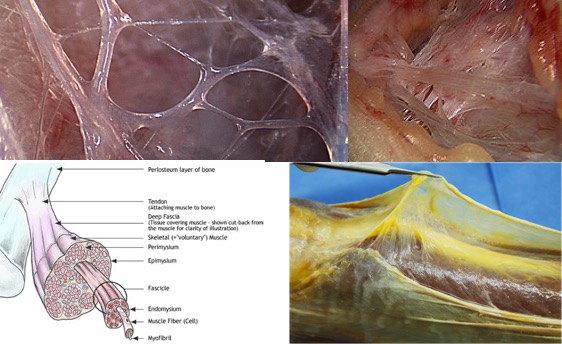Laurie's Blogs.
Sep 2018
What is and why you should learn about myofascial release…

The fascial system is the latest craze in the health care providers’ arena. Rightly so! It’s been a missing link for far too long, and just more recently have ‘the masses’ started to take a serious look at all that the fascial system can impact. Let’s dive in.
Fascia is the cotton-candy like structure that is between all ‘stuff’ in your body. It is around all of your organs (it’s actually what keeps your organs in place. If fascia wasn’t there, then gravity would drag all of your innards down into your pelvis! Wouldn’t that be uncomfortable!) It envelopes all of your muscles, and muscle groups, and each muscle fibre and fascicle! It’s within and under your skin and not only keeps things in place, but allows bits to slide and glide. Your blood vessels and nerves run through it… everywhere. It’s a fluid transport system. It is possibly a light transport system. It is so much more than we give it credit for!
When you get an injury, a few things might happen that affect your fascia. Fascia can be injured and torn with an injury… and as such, need to heal just like muscle or tendon. Fascia can dry up and get stuck together (i.e. following an abdominal surgery and exposure of the visceral fascia to air). Fascia can become over stretched as in the case of bad posture, weak abdominals, or a hypermobility. Fascia can also become too tight, as with bad posture (and the opposite muscles as the ones that are over stretched), compensations for an injury, overuse, or due to scarring.
So, when would you use myofascial release? Well, quite frankly, it has a purpose with just about any case! Let me give you a recent example. A colleague sent me a message asking about a 7-week-old puppy she’s seeing with a roached / rounded topline and a sacroiliac joint dysfunction. I have seen dozens of cases like this! My advice was to mobilize the SIJ… get it comfortable again, and then work on myofascial releases to address the rounded back. You see if a puppy has a pain in the butt, he/she will tuck in the pelvis and hold a rounded posture. If you let that go on for too long, then the fascia and muscles on the ventral surface of the spine will shorten or fail to elongate… thus perpetuating the problem. However, if you catch it early, address the root of the problem (i.e. the SIJ) and combine that with myofascial work, then you can restore that puppy’s topline!!!
How does it work? Some myofascial techniques are just like stretches, and in fact, stretching is a myofascial technique. Other myofascial techniques are smaller and more direct on the target tissue, and still others are broader and incorporate multiple joints and body parts! Lifting of the tissues is a myofascial technique. Pressing on tissues is a myofascial technique. Separating tissues is a myofascial technique. Twisting, rolling, gapping, brushing… are all myofascial techniques.
The trick with fascia is that it’s ‘plastic’, which means it’s not very elastic. So, if you want to change the length of the tissues (aka fascia) then you need to come at it slowly. To try to stretch, spread, gap, twist, or deform fascia quickly results in rigidity. As such, myofascial holds are entered into slowly. Additionally, fascia takes a bit longer to release (which is literally to change of the ground substance around the fascia from a solid state to a more liquid state). So, you need to hold your ‘release’ for longer than a typical stretch. 60 – 90 or 120 seconds! One book I read even says 5 minutes! (I just get too bored to hang out for 5 minutes, but I can do 60 seconds!) It can be very Zen-like and calming (for both the practitioner and the therapist)!
All in all, if your patient had a surgery, you should add myofascial technique to the incision, and to the tissues that are compensating for the surgery. If your patient has joint pain, you can do myofascial techniques over the affected joint, and to any compensations. If your patient has developed bad posture… myofascial techniques. If your patient had an injury… you get the picture by now! No patient is free of myofascial dysfunction!
So, what are you doing to learn about myofascial techniques and adding them to your practice?
I’ve got a couple of educational options to help you out:
October 2018 in California: www.atlasrehabforcanines.com
April 2019 in New Jersey: www.staarconference.com
Maybe see ya there! Happy learning!
Cheers, Laurie


